Top 10 Best AI Developers of 2025
In 2025, building AI agents has become more streamlined and accessible with tools like LangGraph, an innovative framework designed to simplify the development of intelligent systems. LangGraph allows developers to create powerful AI agents by connecting various natural language processing (NLP) models, APIs, and external data sources in a seamless, visual workflow. This enables faster prototyping and deployment of AI solutions tailored to specific business needs.
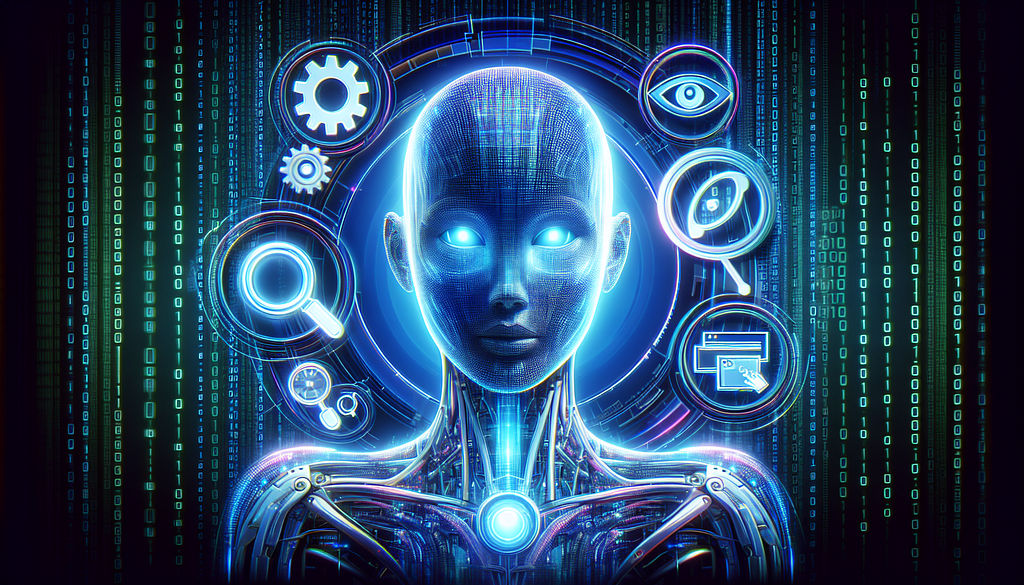
By integrating LangGraph into your development process, you can easily create agents that understand, process, and respond to human language, making them ideal for applications in customer service, content generation, automation, and more. Whether you are building conversational bots, personalized recommendation systems, or automated assistants, LangGraph provides a robust foundation that empowers you to design smarter, more adaptable AI agent development. With its user-friendly interface and extensive support for advanced AI capabilities, LangGraph is a game-changer for developers looking to stay ahead in the rapidly evolving AI landscape of 2025.
What is an AI Agent?An AI agent is a software system designed to autonomously perform tasks or make decisions based on data inputs, using artificial intelligence techniques such as machine learning, natural language processing, and reasoning. These agents can interact with users or other systems, interpret information, and take actions without human intervention, often optimizing their behavior over time through learning. AI agents are commonly employed in applications such as virtual assistants, chatbots, recommendation engines, and autonomous vehicles. They analyze their environment, process data, and make decisions to achieve specific goals, adapting to changing conditions as needed.
By leveraging algorithms, AI agents can simulate human-like cognitive functions, such as understanding language, recognizing patterns, and solving complex problems. With advancements in AI technologies, these agents are becoming increasingly sophisticated, capable of handling more intricate tasks and delivering personalized experiences in various industries, including customer service, healthcare, finance, and entertainment. As AI continues to evolve, the role of AI agents is expanding, revolutionizing automation and human-computer interaction.
Understanding LangGraphLangGraph is an advanced framework that simplifies the development of AI agents by providing a visual interface to integrate and connect various natural language processing (NLP) models, APIs, and data sources. Designed to streamline AI development, LangGraph enables developers to build intelligent systems quickly and efficiently without needing to write complex code. It allows for the creation of customized workflows, where different AI models and components can be linked to process language, make decisions, and take actions autonomously.
With LangGraph, developers can easily create applications like chatbots, virtual assistants, and recommendation engines by visually mapping out the AI processes, ensuring smoother integration and faster deployment. The platform also offers powerful tools for automation, natural language understanding, and decision-making, helping developers build adaptable, intelligent agents that can improve over time. LangGraph’s flexibility and ease of use make it a valuable tool for businesses looking to leverage AI for a variety of applications, from customer service to advanced automation.
Key Features of LangGraph for AI Agent DevelopmentLangGraph is a powerful framework designed for building and managing AI agents, making it easier to create complex workflows, integrate various data sources, and develop intelligent systems. Here are some key features that make LangGraph stand out in AI agent development:
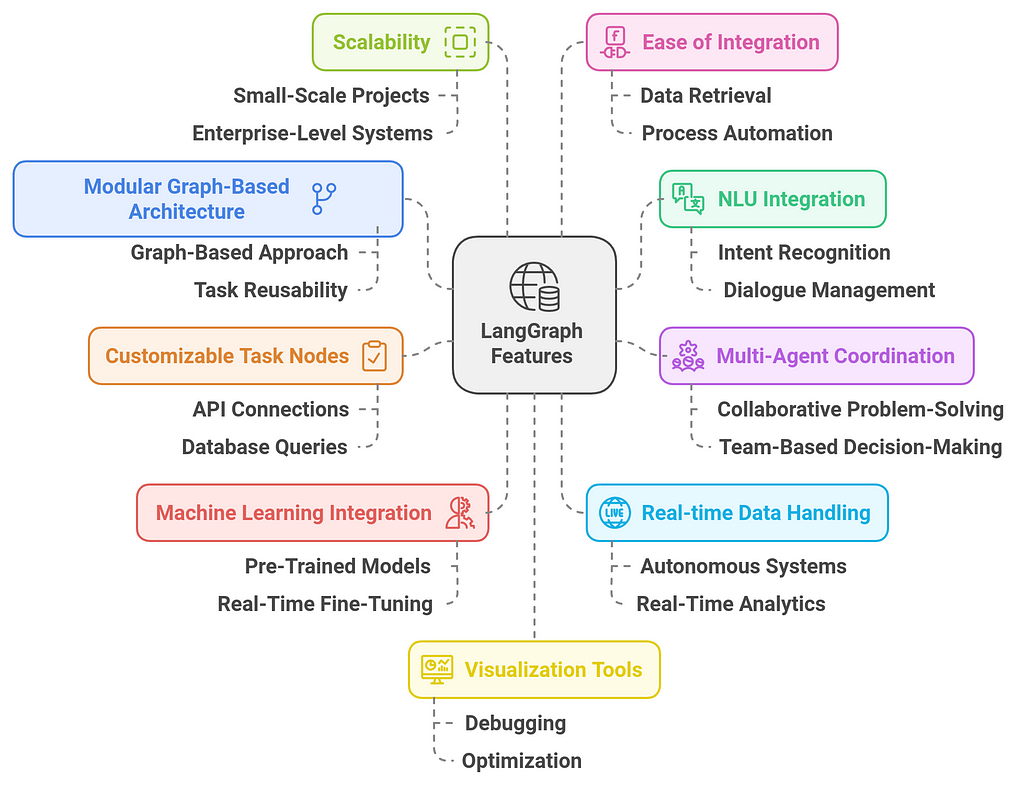
- Modular Graph-Based Architecture: LangGraph leverages a graph-based approach where each node in the graph represents a task or operation. This structure allows for easy composition of complex workflows by connecting different tasks, promoting reusability and flexibility in AI agent development.
- Natural Language Understanding (NLU) Integration: It supports NLU capabilities, allowing the AI agent to better interpret and understand human language, which is key for tasks like intent recognition and dialogue management.
- Multi-Agent Coordination: LangGraph can manage multiple AI agents working together, making it suitable for more sophisticated tasks like collaborative problem-solving, team-based decision-making, or complex workflows that require coordination.
- Customizable Task Nodes: Developers can create custom nodes in the graph, allowing the integration of specific functionalities, such as connecting APIs, querying databases, or executing machine learning models, providing flexibility for different use cases.
- Built-in Machine Learning Integration: LangGraph seamlessly integrates with machine learning models, enabling AI agents to leverage pre-trained models or fine-tune models based on real-time data, improving the agent’s performance over time.
- Real-time Data Handling: LangGraph handles real-time data input and processing, allowing AI agents to make decisions based on the latest available information, which is critical for applications like autonomous systems or real-time analytics.
- Scalability: The framework is designed to scale with the complexity of the system, making it suitable for both small-scale projects and large, enterprise-level AI agent systems.
- Ease of Integration: LangGraph provides tools to easily integrate with external systems, APIs, and platforms, supporting tasks such as data retrieval, process automation, or communication with other software tools.
- Visualization Tools: Developers can visualize the AI agent’s decision-making process through an intuitive graphical interface, helping in debugging, optimization, and monitoring the agent’s performance.
- Support for Reinforcement Learning: LangGraph can also incorporate reinforcement learning algorithms, enabling agents to learn optimal behaviors through interactions with the environment or users.
These features make LangGraph a highly versatile and powerful framework for building sophisticated AI agents, suitable for a wide range of applications across different industries.
The Need for Building AI AgentsBuilding AI agents has become increasingly important across industries due to the numerous benefits they offer in automating processes, enhancing user experiences, and solving complex problems. Here are some key reasons why building AI agents is essential:
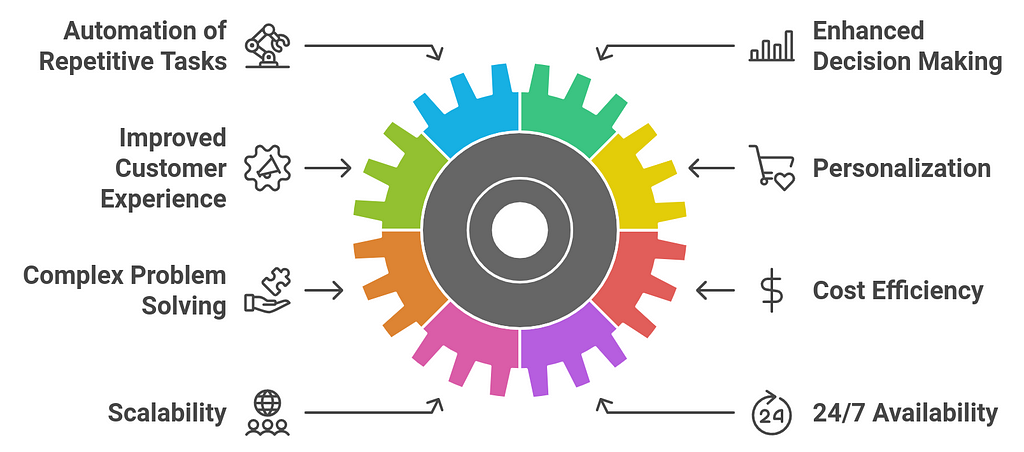 1. Automation of Repetitive Tasks
1. Automation of Repetitive TasksAI agents can automate mundane and repetitive tasks, allowing businesses and individuals to focus on more strategic activities. For example, customer support agents, virtual assistants, or task management bots can take over routine inquiries and processes, significantly improving efficiency and productivity.
2. Enhanced Decision MakingAI agents can analyze vast amounts of data in real time to provide actionable insights. In sectors like finance, healthcare, and retail, AI agents help businesses make data-driven decisions by identifying trends, patterns, and anomalies that might be missed by humans.
3. Improved Customer ExperienceAI agents, like chatbots and virtual assistants, are instrumental in providing instant, personalized responses to customers. They can handle a wide range of customer service functions, ensuring faster response times, 24/7 availability, and more engaging interactions, leading to better customer satisfaction.
4. PersonalizationAI agents can analyze individual user behavior and preferences, offering personalized recommendations, services, or products. In e-commerce, entertainment, and marketing, AI agents enable hyper-targeted approaches, which can boost user engagement, sales, and retention.
5. Complex Problem SolvingAI agents are particularly suited for solving complex problems that require handling large datasets, intricate decision-making processes, and sophisticated modeling. They are used in fields like healthcare for diagnostic assistance, autonomous vehicles for navigation, and supply chain management for optimization.
6. Cost EfficiencyBy automating tasks and improving operational efficiency, AI agents can reduce costs significantly. This is especially crucial for industries like customer support, logistics, and manufacturing, where AI can lower the need for human intervention and increase throughput without compromising quality.
7. ScalabilityAI agents can easily scale operations, handling an increasing volume of tasks without a linear increase in costs or resources. For businesses experiencing growth or needing to expand services quickly, AI agents provide a way to meet demand without the need to hire and train additional personnel.
8. 24/7 AvailabilityAI agents are not constrained by working hours, enabling businesses to provide continuous support and service. Whether it’s monitoring systems, handling customer inquiries, or performing maintenance tasks, AI agents can work round the clock without breaks, improving operational continuity.
9. Learning and AdaptationWith the integration of machine learning and reinforcement learning, AI agents can continuously learn from their interactions and improve their performance over time. This capability enables them to adapt to changing conditions and provide more accurate or relevant outputs as they accumulate more data and experience.
10. Innovation and Competitive AdvantageImplementing AI agents can drive innovation by creating new possibilities for interaction, service delivery, and business models. Companies leveraging AI can gain a competitive edge by offering cutting-edge technology solutions, optimizing operations, or creating new, AI-powered products or services.
11. Handling Big DataAI agents excel at managing and analyzing vast amounts of unstructured data. In industries like finance, healthcare, and research, they can sift through large datasets, draw valuable insights, and even predict future trends based on historical data, which would be impractical for humans to do manually.
12. Enhanced Security and Risk ManagementAI agents can monitor systems for security threats in real-time, identifying vulnerabilities and potential attacks faster than humans can. They can also help in risk assessment, fraud detection, and ensuring compliance in highly regulated industries.
13. Empowering Creativity and InnovationAI agents can assist in creative processes by generating content, designs, or ideas based on predefined parameters. This can be particularly useful in fields like marketing, content creation, and product design, where AI can act as a co-creator, suggesting new possibilities and pushing boundaries.
Building AI agents is no longer a luxury it’s a necessity for businesses and organizations seeking to stay competitive in an increasingly digital and data-driven world. With the ability to automate, personalize, scale, and enhance decision-making, AI agents are transforming how companies operate, interact with customers, and innovate across industries.
How can LangGraph Built AI Agents Enhance Experience?LangGraph’s framework for building AI agents offers several unique features that can significantly enhance user experience. By leveraging its modular graph-based structure, natural language processing (NLP) capabilities, and integration with machine learning, LangGraph AI agents can provide a seamless, intelligent, and personalized interaction for users across different applications. Here’s how LangGraph-built AI agents can enhance user experience:
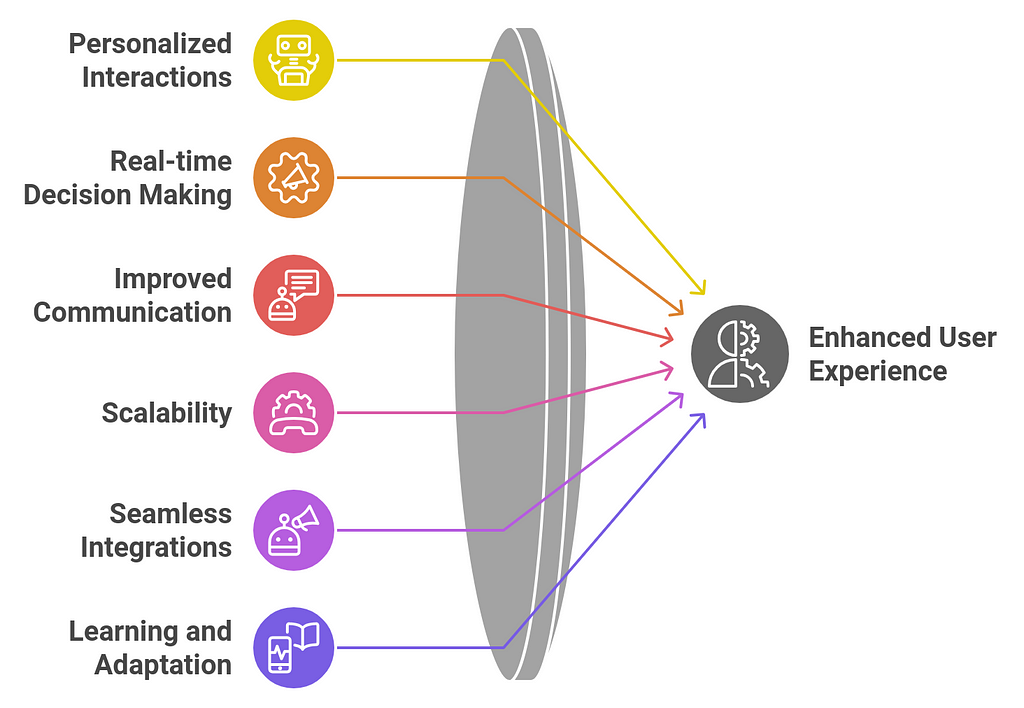 1. Personalized Interactions
1. Personalized Interactions- Customizable Workflows: LangGraph allows developers to build AI agents that adapt to individual user preferences and behaviors. By using data-driven insights, AI agents can tailor interactions to match a user’s past actions, likes, and preferences. This personalization creates a more relevant and engaging experience for users.
- Context Awareness: LangGraph’s ability to integrate context into its workflows means that AI agents can remember user interactions across sessions, providing more fluid and meaningful exchanges. For example, an AI agent could pick up from where a conversation last left off, making it feel more like a natural, ongoing dialogue.
- Instant Data Processing: LangGraph integrates real-time data streams and external systems, enabling agents to make decisions based on up-to-the-minute information. This is crucial in applications like customer support, where AI agents can resolve issues quickly by pulling relevant data and providing timely solutions.
- Instant Responses: AI agents built with LangGraph can process inputs and respond instantly, providing users with immediate feedback and responses. This eliminates wait times, improving overall user satisfaction and making the experience more efficient.
- Natural Language Understanding (NLU): LangGraph’s integration with NLU enables AI agents to understand and respond to user inputs in a conversational, human-like manner. This creates a more intuitive and engaging experience, especially in chatbots and virtual assistants where users expect natural, conversational exchanges.
- Multilingual Capabilities: LangGraph can be extended to handle multiple languages, enabling global user bases to interact with AI agents in their native languages, further enhancing accessibility and inclusivity.
- Handling Complex Queries: LangGraph’s modular design and AI capabilities allow it to scale efficiently without losing performance. Whether handling a single user or managing interactions across thousands of users, LangGraph-built agents can maintain high-quality experiences at scale.
- Support for Multiple Agents: LangGraph can manage multiple agents working simultaneously in a coordinated manner. For instance, in customer service applications, multiple agents can be used to handle different aspects of user inquiries, such as billing, technical support, or sales, each providing focused and efficient service.
- API and Service Integration: LangGraph’s ability to integrate with external services and APIs allows AI agents to seamlessly fetch data from a wide variety of sources, such as databases, external platforms, or third-party services. This can enrich the user experience by providing detailed, real-time information in a variety of contexts, like flight booking, order tracking, or product recommendations.
- Omnichannel Support: AI agents built with LangGraph can be deployed across multiple channels — web, mobile, and messaging apps — ensuring users have consistent and cohesive experiences regardless of where they interact with the agent.
- Continuous Improvement: LangGraph AI agents can be integrated with machine learning algorithms to continuously improve based on user interactions. For example, an AI agent can adapt its responses based on past conversations, learning which phrases and tones are more effective in keeping the user engaged or resolving their issues.
- Behavioral Learning: Using reinforcement learning and feedback loops, LangGraph can enable agents to improve over time, refining their understanding of user intent and offering more precise, helpful, and contextually relevant interactions.
- Predictive Capabilities: By analyzing user data and interaction patterns, LangGraph-powered agents can proactively anticipate user needs. For example, an AI agent might suggest relevant content or solutions before the user explicitly asks for them, creating a more intuitive and helpful user experience.
- Contextual Suggestions: In e-commerce, LangGraph-powered agents can recommend products based on previous purchases, browsing behavior, or trends, creating a more tailored shopping experience.
- Simplified User Journeys: LangGraph enables the creation of AI agents that guide users through complex workflows or tasks, breaking down complicated processes into smaller, more manageable steps. This can be particularly helpful in areas like onboarding, technical troubleshooting, or multi-step transactions, where users might feel overwhelmed.
- Error Handling and Recovery: LangGraph’s AI agents are designed to handle errors gracefully, guiding users through troubleshooting steps when things go wrong and ensuring that users are not left confused or frustrated.
- Data Privacy: LangGraph allows developers to implement strong privacy policies and controls, ensuring that sensitive user data is handled securely. This builds trust with users, as they can feel confident that their information is protected.
- Ethical AI Interactions: LangGraph can help ensure AI agents adhere to ethical standards, such as transparency, fairness, and accountability. This is critical for user trust, especially when dealing with sensitive topics like healthcare or financial services.
- Visual Feedback: LangGraph’s built-in visualization tools help developers monitor agent performance and identify areas for improvement. By observing how agents interact with users, developers can make informed adjustments, ensuring that the AI agent continues to provide a smooth and effective user experience.
- Data-Driven Optimization: With detailed insights into agent behavior and user interactions, LangGraph allows for continuous optimization, ensuring the AI agents evolve to meet changing user needs.
AI agents built with LangGraph enhance the user experience by offering personalization, seamless integration, intelligent decision-making, and real-time responsiveness. The flexibility and scalability of LangGraph empower developers to create AI agents that deliver intuitive, efficient, and human-like interactions across a wide range of industries and applications. Whether it’s improving customer support, providing personalized recommendations, or automating workflows, LangGraph AI agents elevate the quality of user interactions and drive satisfaction.
How Are AI Agents Changing The Traditional Ways?AI agents are dramatically transforming traditional methods of conducting business, interacting with customers, and solving problems. These intelligent systems are reshaping industries by introducing automation, efficiency, personalization, and new ways of working. Here’s how AI agents are changing traditional ways:
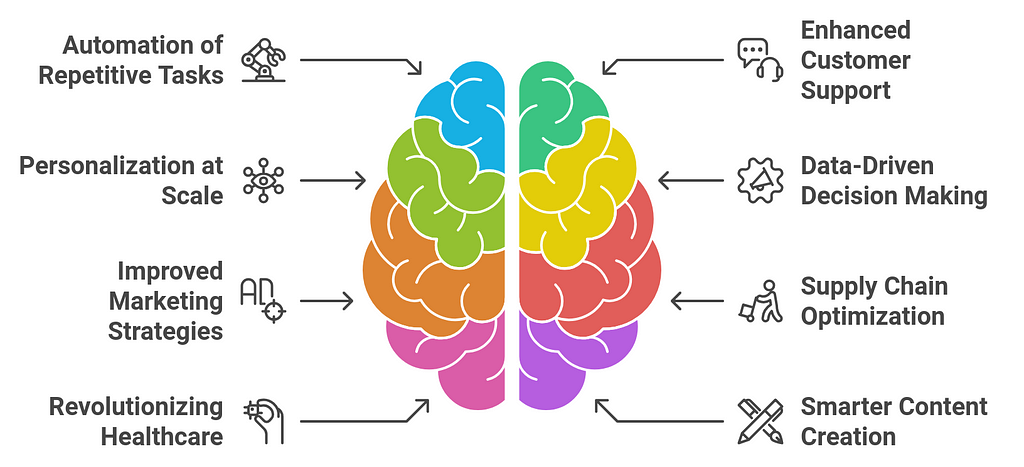 1. Automation of Repetitive Tasks
1. Automation of Repetitive Tasks- Traditional Approach: Many businesses rely on human labor to handle routine, time-consuming tasks, such as answering customer queries, processing invoices, or managing inventory.
- AI Agent Impact: AI agents, such as chatbots, virtual assistants, and robotic process automation (RPA) tools, now handle these repetitive tasks, freeing up human workers to focus on more strategic, creative, and high-value activities. This shift enhances efficiency, reduces operational costs, and improves productivity.
- Traditional Approach: Customer support typically relied on human agents working in call centers or responding to emails, often with long wait times and limited availability.
- AI Agent Impact: AI-powered chatbots and virtual assistants provide 24/7 customer support, answering frequently asked questions, resolving issues, and providing real-time assistance across various platforms. This ensures faster response times, reduces wait times, and allows customers to get immediate help, improving overall satisfaction.
- Traditional Approach: Personalization in traditional systems often requires manual intervention, such as marketing teams segmenting customer data or tailoring product offerings based on limited insights.
- AI Agent Impact: AI agents can analyze large volumes of data to deliver hyper-personalized experiences at scale. For example, e-commerce platforms can use AI to recommend products based on browsing history, previous purchases, or behavioral patterns, providing users with relevant suggestions and creating a more engaging and customized experience.
- Traditional Approach: Decision-making was often based on historical data, intuition, and human experience, which sometimes led to slower, less accurate outcomes.
- AI Agent Impact: AI agents use advanced algorithms to analyze vast amounts of structured and unstructured data, providing real-time insights and recommendations. In industries like healthcare, finance, and marketing, AI agents help businesses make data-driven decisions quickly and accurately, improving outcomes and reducing risk.
- Traditional Approach: Marketing campaigns in traditional settings often rely on broad demographic data, with limited ability to target and personalize content for individual customers.
- AI Agent Impact: AI-driven marketing tools enable highly targeted and personalized campaigns, where AI agents can analyze user behavior, predict future needs, and create tailored messaging. These AI systems optimize ad spending, analyze customer sentiment, and improve ROI by ensuring that the right message reaches the right audience at the right time.
- Traditional Approach: Supply chain management in traditional industries involves manual coordination of inventory, demand forecasting, and logistics, leading to inefficiencies and delays.
- AI Agent Impact: AI agents can predict demand trends, optimize delivery routes, and manage inventory in real-time. By automating and optimizing these processes, AI systems improve efficiency, reduce waste, and ensure that the right products are available at the right time, ultimately cutting costs and enhancing service delivery.
- Traditional Approach: Healthcare relied heavily on manual processes, such as patient data entry, scheduling, and diagnosis, which were time-consuming and error-prone.
- AI Agent Impact: AI agents are transforming healthcare by assisting in diagnostics (e.g., image recognition for detecting diseases), personalized treatment plans, and automating administrative tasks like scheduling and billing. They also improve patient engagement through virtual health assistants that provide medical advice, reminders, and continuous monitoring.
- Traditional Approach: Content creation, whether for marketing, media, or entertainment, required substantial human input, research, and creativity, often taking time to generate content that resonated with audiences.
- AI Agent Impact: AI agents are revolutionizing content creation by generating articles, reports, advertisements, and even video content based on predefined parameters. Tools like AI writers and video editors help companies create high-quality content faster and more efficiently, enabling scaling of content production without increasing resources.
- Traditional Approach: Risk management and security rely on human oversight, monitoring, and intervention, often leading to slow responses to emerging threats.
- AI Agent Impact: AI agents are increasingly used for proactive risk management, detecting potential threats (e.g., fraud, cybersecurity breaches, or financial irregularities) before they occur. They can monitor systems in real-time, identify vulnerabilities, and take preventive actions, improving security and reducing risks in real time.
- Traditional Approach: Financial services such as loans, investments, and trading require human brokers and manual processes, often leading to inefficiencies and delays.
- AI Agent Impact: AI agents in the finance industry are automating processes like credit scoring, fraud detection, algorithmic trading, and customer support. For example, AI systems can analyze creditworthiness based on a wider range of data, offering quicker decisions and reducing human biases. They can also optimize trading strategies based on real-time market analysis.
- Traditional Approach: Manufacturing processes often involve a high degree of manual labor, quality control, and machine maintenance, with human intervention required for adjustments and troubleshooting.
- AI Agent Impact: AI-powered robots, predictive maintenance systems, and automated production lines are transforming manufacturing by increasing throughput, reducing downtime, and ensuring high product quality. AI agents can predict when machines need maintenance, avoiding costly breakdowns and ensuring smooth operations.
- Traditional Approach: Traditional education methods involve standardized curriculums, with limited opportunities for personalized learning or immediate feedback.
- AI Agent Impact: AI-powered tutoring systems and learning platforms provide personalized learning experiences by adapting to each student’s pace and needs. AI agents can identify knowledge gaps, recommend relevant resources, and provide instant feedback, enhancing the learning experience and enabling more efficient education delivery.
- Traditional Approach: In many industries, employees were expected to perform tasks independently, relying solely on their skills and experience.
- AI Agent Impact: AI agents are increasingly being used to augment human capabilities. In fields like design, engineering, and medicine, AI acts as an assistant that can help professionals make better, faster decisions by providing them with insights, recommendations, and automation tools that streamline their work.
AI agents are fundamentally reshaping the way businesses and individuals operate, offering more efficient, accurate, and personalized solutions than traditional methods. By automating repetitive tasks, enhancing decision-making, improving customer interactions, and optimizing processes, AI agents are transforming industries and enabling organizations to operate more effectively in the modern, data-driven world. These changes not only improve business operations but also offer customers and end-users more intuitive, efficient, and satisfying experiences.
Getting Started: Setting Up LangGraphGetting started with LangGraph for AI agent development involves several steps to set up the environment, install dependencies, and start building your first AI agent. Below is a step-by-step guide to help you get up and running with LangGraph:
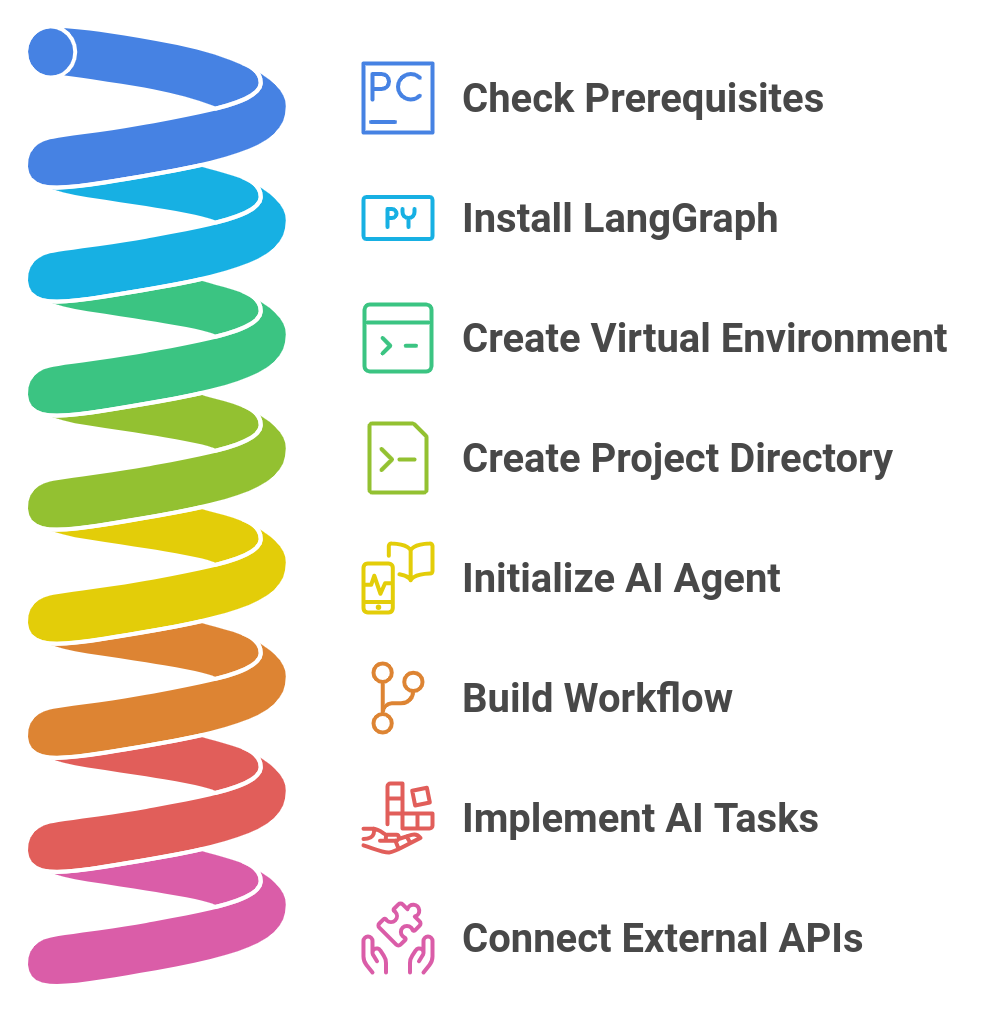 1. Prerequisites
1. PrerequisitesBefore setting up LangGraph, make sure you have the following:
- Python: LangGraph typically works with Python. Ensure that you have Python 3.6 or later installed on your system.
- IDE or Text Editor: You can use any Python IDE or code editor like Visual Studio Code, PyCharm, or even a simple text editor like Sublime Text.
- Pip: The Python package manager (pip) is required to install dependencies and libraries.
First, you’ll need to install LangGraph using pip. You can do this by running the following command in your terminal or command prompt:
pip install langgraphIf LangGraph isn’t available pip yet, you may need to check for specific installation instructions from the LangGraph documentation or its repository.
3. Set Up a New ProjectOnce LangGraph is installed, you can start a new project to develop your AI agent. It’s a good idea to create a new virtual environment for your project to keep dependencies isolated.
- Create a Virtual Environment (optional but recommended):
- On Linux/macOS:
source langgraph-env/bin/activate
On Windows:
python -m venv langgraph-envlanggraph-env\Scripts\activate
- Create a Project Directory:
You can now create a folder for your project:
mkdir my_langgraph_projectcd my_langgraph_project4. Set Up the Graph Structure
LangGraph uses a graph-based architecture for building workflows. Each node in the graph can represent different operations, tasks, or agents, and connecting them forms a pipeline.
- Initialize Your Agent: To get started, you’ll want to define an AI agent that interacts with the environment. You might start by importing the necessary modules and creating a basic agent structure.
# Create an agent
agent = Agent(name="MyAI")
2. Build the Workflow: LangGraph’s main strength lies in its ability to build workflows using interconnected nodes. For example, a node might represent a task like data collection or language processing, and they can be linked to form a larger workflow.
# Define nodes in the graph (tasks or actions)task1 = Node(name="Collect Data", operation=collect_data_function)
task2 = Node(name="Process Data", operation=process_data_function)
task3 = Node(name="Provide Output", operation=output_function)
# Create a graph
graph = Graph(name="MyAI Workflow")
# Add nodes to the graph and connect them
graph.add_node(task1)
graph.add_node(task2)
graph.add_node(task3)
graph.connect(task1, task2) # Connect tasks in the desired order
graph.connect(task2, task3)5. Implement AI Tasks
LangGraph allows you to define custom operations (tasks) that the agent will perform at each node. These tasks can include machine learning, natural language processing, API calls, or other functions.
1. Define a Custom Node Function:- You can implement your logic in the functions that each node will execute. For example, a simple function to collect data could look like this:
data = "Sample data collected"
return data
2. Add Machine Learning or NLP Tasks: LangGraph can integrate machine learning models or NLP tasks as nodes. For example, a node that processes natural language could be implemented as follows:
from langgraph import Nodedef process_data_function(data):
# Simulate an NLP task, like text processing
processed_data = data.lower() # Simple data processing example
return processed_data
task2 = Node(name="Process Data", operation=process_data_function)6. Connect External APIs or Services
LangGraph can be integrated with external APIs, databases, or cloud services to fetch or send data. You can create nodes to call these services and integrate them into your workflow.
For example, a node could call an external API to fetch data:
import requestsdef api_call_function():
response = requests.get("https://api.example.com/data")
return response.json()
task1 = Node(name="API Data Fetch", operation=api_call_function)7. Execute the Agent
Once the workflow and nodes are set up, you can execute the agent’s task flow:
# Execute the graph (start the agent's workflow)agent.execute(graph)
This will run the tasks sequentially, passing data through the nodes according to the graph’s connections.
8. Monitor and DebugLangGraph may provide monitoring and debugging tools to help you visualize the flow of data through the nodes, making it easier to debug and optimize your agent’s performance.
You can track performance metrics, visualize the execution graph, and fine-tune tasks to improve the agent’s output.
9. Deploy the AgentOnce your agent is working locally, you may want to deploy it to a production environment. Depending on your use case, you can integrate your LangGraph AI agent into web applications, mobile apps, or even cloud platforms like AWS, GCP, or Azure.
10. Iterate and ImproveLangGraph is designed for flexibility and scalability, allowing you to continually improve your AI agents. As you collect more data and learn from user interactions, you can refine your agent’s capabilities by adjusting nodes, adding new tasks, or training new models.
Example: Simple AI AgentHere’s a simplified example of setting up a basic LangGraph agent:
from langgraph import Agent, Node, Graph# Define custom node functions
def collect_data():
return "Data collected successfully."
def process_data(data):
return f"Processed: {data}"
def output(data):
print(f"Final output: {data}")
# Create the agent and graph
agent = Agent(name="SimpleAI")
graph = Graph(name="Simple Workflow")
# Create and add nodes
task1 = Node(name="Collect Data", operation=collect_data)
task2 = Node(name="Process Data", operation=process_data)
task3 = Node(name="Output Result", operation=output)
graph.add_node(task1)
graph.add_node(task2)
graph.add_node(task3)
# Connect nodes
graph.connect(task1, task2)
graph.connect(task2, task3)
# Execute the agent
agent.execute(graph)
Setting up LangGraph to develop AI agents involves installing the framework, creating a new project, defining tasks and nodes, and connecting them to form workflows. The framework’s modular approach allows you to easily integrate custom logic, machine learning models, or external services, and it provides a flexible way to build scalable AI agents. With LangGraph, you can quickly get started with AI agent development and start creating intelligent systems for a variety of use cases.
Advanced Techniques for Building Robust AI AgentsBuilding robust AI agents with LangGraph involves utilizing advanced techniques that enhance the intelligence, scalability, and adaptability of the agent. These techniques are designed to handle more complex tasks, improve decision-making, and ensure the agent operates efficiently and securely across various environments. Here are some advanced methods you can use to build high-performance AI agents using LangGraph:
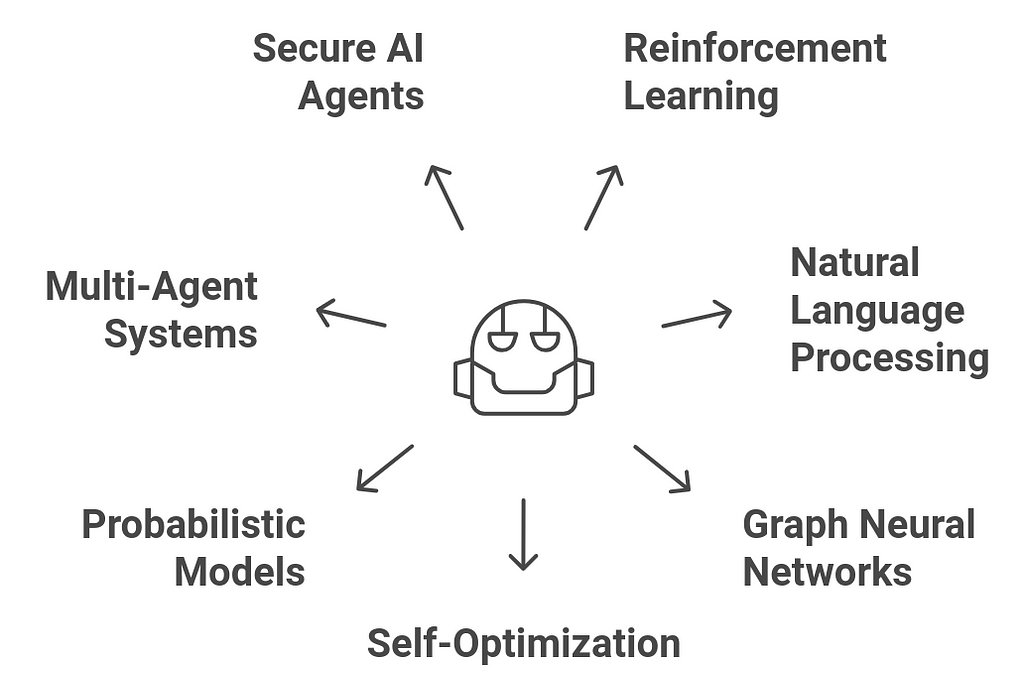 1. Incorporating Reinforcement Learning (RL) for Adaptation
1. Incorporating Reinforcement Learning (RL) for AdaptationReinforcement learning enables an agent to learn from its environment by receiving feedback and adjusting its actions over time. In the context of LangGraph, you can integrate RL algorithms to improve an agent’s ability to make decisions in dynamic, uncertain environments.
Use Case: An AI agent designed for customer support can learn optimal responses by interacting with users and observing the effectiveness of its responses.
Implementation:
- Define a reward function that quantifies the success of an action.
- Use RL libraries (like stable-baselines3 or TensorFlow) to implement Q-learning, policy gradient methods, or actor-critic algorithms.
- Integrate these RL models as a node within LangGraph, so the agent can adjust its actions based on accumulated rewards.
Example:
from stable_baselines3 import PPOfrom langgraph import Node
def reinforcement_learning_function(state):
model = PPO.load("agent_model") # Load a pre-trained RL model
action = model.predict(state)
return action
rl_node = Node(name="Reinforcement Learning Decision", operation=reinforcement_learning_function)
graph.add_node(rl_node)2. Natural Language Processing (NLP) for Complex Understanding
For AI agents that interact with humans or process text data, integrating advanced NLP techniques can significantly improve the agent’s ability to understand and respond to natural language. You can use pre-trained NLP models, fine-tune models on custom datasets, or combine multiple NLP tasks (e.g., intent recognition, entity extraction, and sentiment analysis).
Techniques:
- Intent Recognition: Classify user intents (e.g., “book a flight,” “order a pizza”) using NLP models like BERT, GPT, or custom models.
- Named Entity Recognition (NER): Extract relevant entities (e.g., locations, dates, names) from the text.
- Summarization: Generate concise summaries of long texts or reports.
Example (using Hugging Face’s transformers library for NER):
from transformers import pipelinefrom langgraph import Node
# Load the NER pipeline
ner_pipeline = pipeline("ner", model="dbmdz/bert-large-cased-finetuned-conll03-english")
def extract_entities(text):
return ner_pipeline(text)
ner_node = Node(name="Entity Extraction", operation=extract_entities)
graph.add_node(ner_node)3. Graph Neural Networks (GNNs) for Structured Data
Graph Neural Networks (GNNs) can be used to process and analyze structured data in graph form. If your AI agent needs to work with data that has inherent relationships or connections (such as social networks, knowledge graphs, or recommendation systems), integrating GNNs can significantly enhance its ability to make informed decisions.
Use Case: A recommendation system where users and products are represented as nodes, and interactions are edges. GNNs can be used to predict user preferences based on their network.
Implementation:
- Use frameworks like PyTorch Geometric or DGL to implement GNNs.
- Integrate the GNN model as a node in LangGraph to make decisions based on graph-structured data.
Example (GNN model):
import torchfrom torch_geometric.nn import GCNConv
from langgraph import Node
class GNNModel(torch.nn.Module):
def __init__(self, in_channels, out_channels):
super(GNNModel, self).__init__()
self.conv1 = GCNConv(in_channels, 16)
self.conv2 = GCNConv(16, out_channels)
def forward(self, data):
x, edge_index = data.x, data.edge_index
x = self.conv1(x, edge_index)
x = self.conv2(x, edge_index)
return x
# Define a GNN node function
def gnn_model_function(graph_data):
model = GNNModel(3, 2) # Example GNN model with 3 input features, 2 output features
return model(graph_data)
gnn_node = Node(name="GNN-Based Decision", operation=gnn_model_function)
graph.add_node(gnn_node)4. Self-optimization and Hyperparameter Tuning
For more complex AI agents, self-optimization techniques such as hyperparameter tuning, automated feature engineering, or even neural architecture search (NAS) can be applied to improve performance.
Techniques:
- Bayesian Optimization: Optimize hyperparameters by modeling the objective function and exploring the parameter space efficiently.
- Grid Search/Random Search: Search through a defined set of hyperparameters to find the best-performing configuration.
- Automated Machine Learning (AutoML): Use tools like Google AutoML or H2O.ai to automate the process of training machine learning models and tuning them.
Example (Hyperparameter Tuning with Optuna):
import optunadef objective(trial):
# Define hyperparameters for a machine learning model
n_estimators = trial.suggest_int('n_estimators', 50, 200)
max_depth = trial.suggest_int('max_depth', 3, 12)
# Create a model and evaluate it with the chosen hyperparameters
model = RandomForestClassifier(n_estimators=n_estimators, max_depth=max_depth)
model.fit(X_train, y_train)
return model.score(X_test, y_test)
# Define an Optuna study for optimization
study = optuna.create_study(direction='maximize')
study.optimize(objective, n_trials=100)
# Get the best hyperparameters
print(study.best_params)5. Handling Uncertainty with Probabilistic Models
For AI agents that operate in uncertain environments (e.g., stock prediction, weather forecasting), incorporating probabilistic models or Bayesian networks can improve their decision-making by quantifying uncertainty.
Techniques:
- Bayesian Networks: Use probabilistic graphical models to represent variables and their conditional dependencies.
- Gaussian Processes: A non-parametric method that can model uncertain data.
- Monte Carlo Methods: Used for approximating complex models with uncertainty.
Example (Bayesian Network):
from pomegranate import BayesianNetwork# Create a simple Bayesian Network
model = BayesianNetwork.from_json('bayesian_model.json')
def predict_with_uncertainty(data):
return model.predict(data)
bn_node = Node(name="Probabilistic Decision", operation=predict_with_uncertainty)
graph.add_node(bn_node)6. Multi-Agent Systems and Collaboration
Multi-agent systems (MAS) involve multiple AI agents collaborating or competing to achieve goals. LangGraph can be extended to handle multi-agent workflows, allowing agents to communicate, share information, and collaborate on solving complex tasks.
Techniques:
- Agent Coordination: Define how agents will communicate, share resources, or synchronize tasks (e.g., using message-passing, leader-follower models).
- Task Allocation: Distribute tasks among agents based on their capabilities or specialization.
- Decentralized Decision-Making: Implement agents that make decisions independently but cooperate for a common goal.
Example (Multi-Agent Coordination):
from langgraph import MultiAgentSystem# Define multiple agents with different roles
agent1 = Agent(name="Data Collector", operation=collect_data_function)
agent2 = Agent(name="Data Processor", operation=process_data_function)
# Create a Multi-Agent System to manage communication
mas = MultiAgentSystem()
mas.add_agent(agent1)
mas.add_agent(agent2)
# Agent1 collects data and passes it to Agent2
agent1.connect(agent2)
mas.execute()7. Secure AI Agents
Security is critical in AI systems, especially when they interact with external data sources, APIs, or users. It’s important to integrate secure practices, such as data encryption, secure authentication, and validation of inputs and outputs.
Techniques:
- Data Encryption: Ensure that sensitive data is encrypted at rest and in transit (e.g., using SSL/TLS for communications).
- Secure API Integration: Use authentication mechanisms like OAuth for secure API calls.
- Adversarial Robustness: Implement techniques to ensure your agent is resistant to adversarial attacks or manipulations.
Example (Encrypting Data with SSL/TLS):
import sslimport requests
# Example of making a secure API request using SSL/TLS
context = ssl.create_default_context()
response = requests.get('https://secure-api.com/data', verify=context)
print(response.json())
Designing robust AI agents with LangGraph requires a combination of advanced techniques to improve their intelligence, adaptability, and security. Incorporating reinforcement learning, NLP, graph neural networks, hyperparameter tuning, probabilistic models, and multi-agent systems can significantly enhance performance.
Deploying AI Agents Using LangGraphDeploying AI agents using LangGraph is a streamlined process that simplifies the integration and deployment of intelligent systems. By leveraging LangGraph’s visual workflow, developers can easily connect various AI models, APIs, and data sources to create robust, automated agents. Once the AI agent is built, LangGraph offers seamless deployment options to ensure it performs efficiently in real-world applications. Whether the AI agent is a chatbot, virtual assistant, or recommendation engine, LangGraph allows for effortless scaling and maintenance, ensuring that the agent adapts to changing environments and user needs.
The platform supports a wide range of deployment environments, from cloud-based services to on-premises systems, providing flexibility and control over where and how the AI agent operates. Additionally, LangGraph’s real-time monitoring and analytics tools help track agent performance, making it easier to fine-tune and optimize for improved outcomes. With LangGraph, developers can quickly deploy and manage AI agents, enhancing productivity and driving innovation across industries.
Real-World Applications of LangGraph AI AgentsLangGraph AI agents are versatile tools that can be applied across various industries and domains to solve real-world problems, enhance efficiency, and automate complex processes. By leveraging LangGraph’s capabilities, developers can create intelligent, dynamic systems capable of integrating various data sources, making decisions, and interacting with users in sophisticated ways. Below are some real-world applications of LangGraph AI agents.
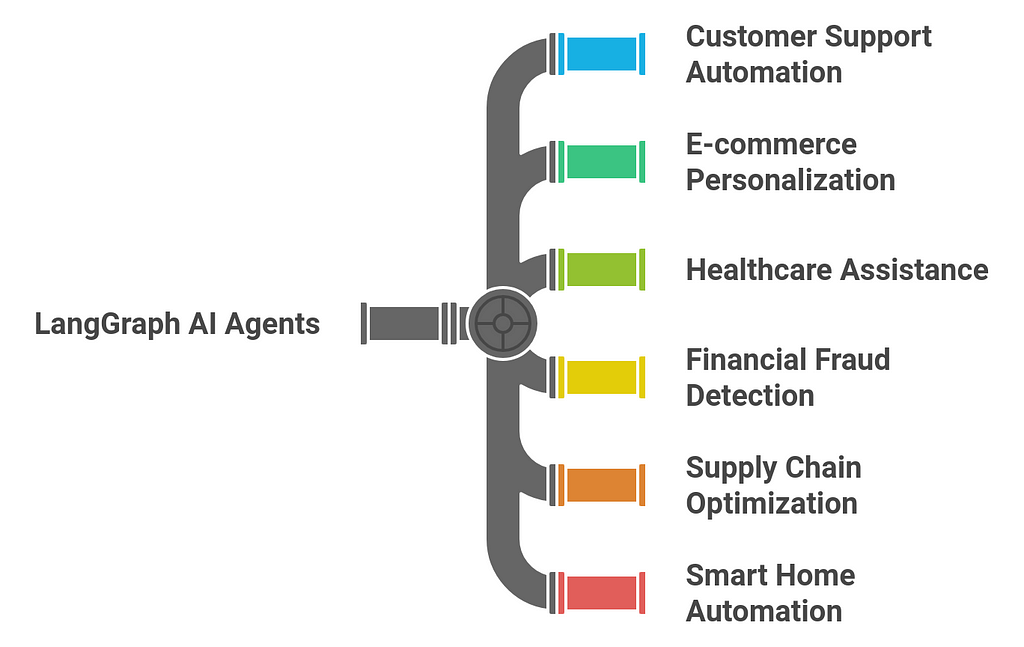 1. Customer Support Automation
1. Customer Support AutomationProblem: Businesses often struggle with managing a large volume of customer queries, leading to delays in responses and suboptimal customer experiences.
Solution: LangGraph AI agents can automate customer support by processing natural language queries, providing instant responses, and escalating issues to human agents when needed. These agents can be trained to understand customer intents, extract relevant information, and interact conversationally.
Example Use Case:
- Agent Functionality: A customer support agent built with LangGraph can analyze customer emails, classify their inquiries, and either respond with predefined answers or forward them to a human agent for complex issues. It can also retrieve customer data from CRMs and databases to offer personalized responses.
- Technologies Used: NLP (Natural Language Processing), Intent Recognition, Chatbots, API Integration with CRM systems.
Real-World Example: Many e-commerce businesses use chatbots and virtual assistants to handle customer inquiries on their websites. These agents help in answering frequently asked questions, processing return requests, and providing product recommendations based on the user’s history.
2. E-commerce Personalization and Recommendation SystemsProblem: E-commerce platforms often have vast inventories, and customers can feel overwhelmed by the choice. Personalized recommendations can drive conversions and improve the shopping experience.
Solution: LangGraph AI agents can analyze customer data (purchase history, browsing behavior, etc.) to generate personalized product recommendations. By using machine learning models integrated into LangGraph, the agents can continuously improve their suggestions based on customer interactions.
Example Use Case:
- Agent Functionality: A recommendation engine can be built as an agent within LangGraph to suggest products based on customer preferences. It can fetch product details from a database, apply user behavior analysis, and suggest items that align with the customer’s taste.
- Technologies Used: Machine Learning, Recommendation Algorithms, Data Processing, and Integration with Product Catalogs.
Real-World Example: Amazon and Netflix use recommendation engines to personalize product and content suggestions based on user activity, thereby increasing user engagement and sales.
3. Healthcare Assistance and DiagnosticsProblem: In healthcare, time is crucial, and providing immediate, accurate medical assistance can be a challenge, especially in remote areas or during after-hours when medical professionals are unavailable.
Solution: LangGraph AI agents can assist in providing diagnostic support, monitoring patient health, and answering medical questions based on symptoms. These agents can also be integrated with electronic health record (EHR) systems to recommend treatments or flag urgent medical concerns.
Example Use Case:
- Agent Functionality: A healthcare assistant built using LangGraph can process patient data (e.g., symptoms, medical history), consult medical databases, and provide potential diagnoses or recommend lifestyle changes. It can also provide automated reminders for medication and appointments.
- Technologies Used: NLP, Data Processing, Machine Learning, Integration with EHR systems.
Real-World Example: AI-powered virtual health assistants, like Babylon Health, use AI agents to provide medical consultations based on patient data, answer health-related queries, and even make initial diagnoses.
4. Financial Services and Fraud DetectionProblem: The financial industry faces challenges with fraud detection, account monitoring, and real-time alerts. Fraudulent activities can result in significant financial loss, and detecting them quickly is key.
Solution: LangGraph AI agents can be trained to monitor transactions in real-time, detect unusual patterns, and flag potential fraud. The agents can also analyze historical data to predict future risks and prevent financial crimes.
Example Use Case:
- Agent Functionality: An AI agent for fraud detection can analyze transaction data in real time, identify suspicious patterns (such as unusual spending behavior or geolocation anomalies), and send immediate alerts to customers and bank officials.
- Technologies Used: Anomaly Detection, Machine Learning, Data Processing, Real-Time Monitoring.
Real-World Example: Banks and payment providers like PayPal and Stripe use AI-powered systems to detect fraudulent transactions by analyzing spending patterns and flagging inconsistencies for further review.
5. Supply Chain Management and LogisticsProblem: Efficient management of supply chains is challenging due to fluctuating demand, inventory levels, transportation logistics, and external factors like weather or political instability.
Solution: LangGraph AI agents can optimize supply chain processes by predicting demand, managing inventory, and optimizing delivery routes. These agents can also monitor supplier performance, assess risks, and automate various administrative tasks within the supply chain.
Example Use Case:
- Agent Functionality: An AI agent could forecast product demand based on historical data and real-time factors, automatically adjust inventory levels, and recommend delivery schedules based on the best routes to minimize delays.
- Technologies Used: Predictive Analytics, Demand Forecasting, Route Optimization, Real-Time Data Integration.
Real-World Example: Companies like Amazon and Walmart use AI agents to streamline their supply chains. Amazon’s AI systems predict product demand, optimize warehouse inventory, and dynamically adjust delivery schedules to improve efficiency.
6. Smart Home AutomationProblem: Home automation systems often struggle with providing personalized, context-aware automation across various devices and tasks.
Solution: LangGraph AI agents can integrate with smart home systems to provide context-aware automation. These agents can analyze user behavior and environmental data (e.g., temperature, time of day, user preferences) to create smart, adaptive routines for controlling lights, heating, security systems, and appliances.
Example Use Case:
- Agent Functionality: A smart home assistant agent can be set to control lights based on the time of day or adjust the temperature when the user leaves or arrives home. The agent can also recommend energy-saving tips and optimize device usage.
- Technologies Used: IoT (Internet of Things), Data Processing, Machine Learning, User Behavior Analysis.
Real-World Example: Devices like Google Home or Amazon Alexa use AI-powered assistants to automate tasks like controlling smart thermostats, security cameras, and lights, all based on voice commands or preset rules.
7. Educational Technology and Personalized LearningProblem: Education systems often fail to provide personalized learning experiences that cater to the unique needs and pace of each student.
Solution: LangGraph AI agents can be used to build personalized learning assistants that analyze students’ strengths, weaknesses, and learning preferences to tailor educational content. These agents can provide real-time feedback, adaptive quizzes, and learning resources that suit individual progress.
Example Use Case:
- Agent Functionality: A personalized learning assistant can analyze a student’s quiz results, identify areas for improvement, and suggest tailored learning materials or exercises to help the student master a particular concept.
- Technologies Used: Adaptive Learning, Natural Language Processing, Data Analytics, Learning Pathways.
Real-World Example: Platforms like Duolingo and Coursera use AI to provide personalized educational experiences by adjusting difficulty levels and recommending lessons based on the learner’s progress.
8. Sentiment Analysis for Brand MonitoringProblem: Businesses need to track public perception and customer sentiment in real-time to address concerns, improve products, or handle PR crises.
Solution: LangGraph AI agents can automatically analyze social media, reviews, and other online content to extract customer sentiment and identify trends. These agents can flag negative sentiment and provide insights into customer feedback, allowing businesses to act proactively.
Example Use Case:
- Agent Functionality: An agent built to monitor brand sentiment can scrape social media platforms and product reviews to determine how customers feel about a brand. The agent can analyze the tone of posts and categorize them as positive, neutral, or negative.
- Technologies Used: Sentiment Analysis, NLP, Social Media Monitoring, Data Analytics.
Real-World Example: Brands like Coca-Cola and Nike use AI-powered sentiment analysis tools to monitor consumer sentiment and adapt marketing strategies accordingly.
9. Travel and Tourism AssistanceProblem: Travelers often face challenges with trip planning, booking flights, and hotels, and managing itineraries in real time.
Solution: LangGraph AI agents can be deployed in travel platforms to provide personalized trip planning, booking assistance, and real-time updates. These agents can offer suggestions on destinations, weather conditions, and local attractions based on user preferences.
Example Use Case:
- Agent Functionality: A travel assistant can help users plan their trips by suggesting destinations, booking accommodations, and creating personalized itineraries. It can also alert users to changes in flight schedules or offer real-time information on local weather and events.
- Technologies Used: Recommendation Systems, Natural Language Processing, Real-Time Data Integration.
Real-World Example: AI agents used by travel companies like Expedia and Kayak assist users in booking flights, suggesting vacation packages, and managing travel details based on user preferences.
LangGraph AI agents have broad applications across industries, from healthcare and finance to customer support and smart homes. These agents can enhance customer experiences, improve operational efficiency, and automate complex workflows. By leveraging machine learning, natural language processing, predictive analytics, and other advanced technologies, LangGraph AI agents can be tailored to meet the specific needs of different business domains, creating smarter, more adaptive systems.
Challenges and Considerations in Using LangGraph for AI Agent DevelopmentWhile LangGraph offers a powerful platform for developing AI agents, there are several challenges and considerations to keep in mind. One key challenge is the need for developers to have a solid understanding of both AI concepts and the LangGraph framework to fully harness its potential. While the visual interface simplifies integration, designing complex workflows and fine-tuning AI models still require expertise. Another consideration is ensuring data privacy and security, particularly when handling sensitive information within AI agents.
Developers must implement robust measures to protect data and comply with regulations such as GDPR. Additionally, LangGraph’s reliance on external APIs and third-party models may introduce potential integration issues or limitations in scalability. As AI technology continues to evolve, staying up-to-date with new features and updates is essential for maintaining optimal performance. Finally, performance optimization is crucial, as AI agents can consume significant computational resources, which may impact deployment costs and efficiency in large-scale applications.
The Future of AI Agents in 2025 and BeyondThe future of AI agents in 2025 and beyond promises a transformative shift in how businesses and individuals interact with technology. Advancements in artificial intelligence, machine learning, natural language processing (NLP), and automation are enabling the development of increasingly sophisticated AI agents capable of handling more complex tasks, offering personalized experiences, and working alongside humans in new and innovative ways. Here are some key trends and predictions for the future of AI agents:
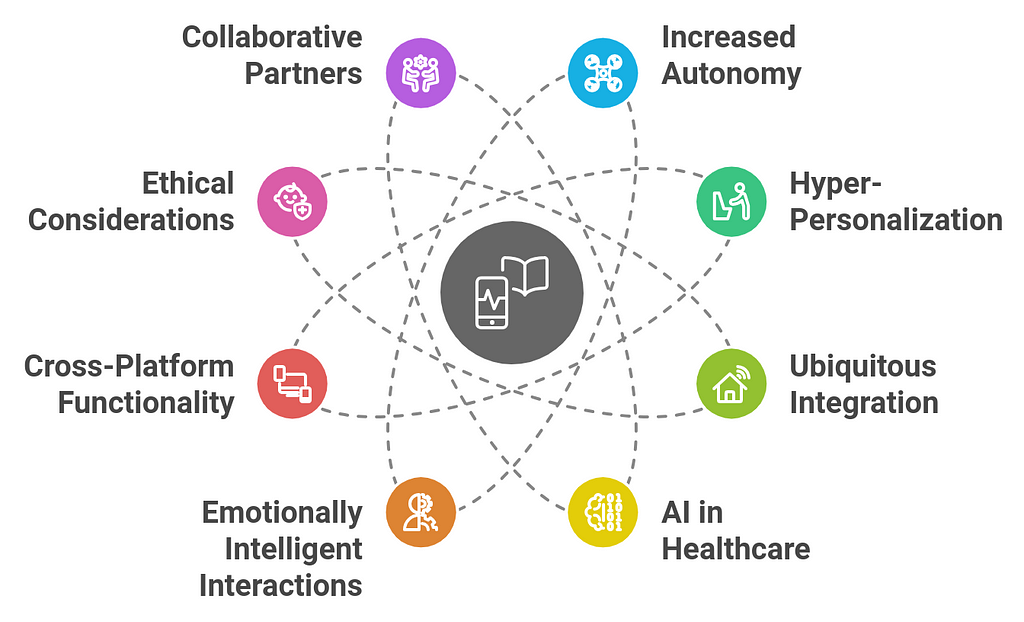 1. Increased Autonomy and Intelligence
1. Increased Autonomy and IntelligenceAs AI technology advances, AI agents will become increasingly autonomous and capable of making independent decisions without constant human intervention. These agents will be able to manage tasks end-to-end, learn from their environment, and adapt their behaviors based on new data and experiences.
- Self-Learning Agents: In the future, AI agents will not only execute predefined tasks but will be able to continuously learn from interactions and optimize their performance. With reinforcement learning and more advanced neural networks, agents will improve their ability to handle complex, unforeseen scenarios.
- Smarter Decision-Making: With more powerful models and access to larger datasets, AI agents will be able to make nuanced decisions in real time, even in highly dynamic environments, such as stock markets or healthcare systems.
Example: A personal assistant AI might become capable of managing your daily schedule autonomously, proactively handling tasks, rebalancing priorities, and even making decisions for you based on changing circumstances.
2. Hyper-PersonalizationAI agents will evolve to offer hyper-personalized experiences by leveraging vast amounts of user data (such as behavioral data, preferences, and past interactions). These agents will not only respond to queries but will anticipate needs and offer solutions tailored specifically to each individual’s preferences.
- Behavioral Understanding: Advanced NLP and emotion-sensing technologies will enable AI agents to read emotions from text, speech, or even facial expressions. This understanding will allow them to adapt their responses and actions based on the emotional context of the conversation.
- Context-Aware Interaction: Future AI agents will have access to a range of contextual information, such as location, time, personal history, and real-time events, enabling them to provide relevant, real-time recommendations and responses.
Example: In 2025, an AI-powered shopping assistant could not only help you find products but could also predict what you’ll need next based on past purchases, your preferences, and even weather patterns or upcoming events.
3. Ubiquitous Integration into Daily LifeAI agents will become integrated seamlessly into all aspects of daily life, from personal devices to work environments, smart cities, and home automation. The boundaries between human and AI-powered tasks will blur, as AI agents become commonplace in virtually every industry.
- Workplace Integration: AI agents will serve as personal assistants, collaborative team members, and problem-solving tools in the workplace. They’ll handle repetitive tasks, assist with decision-making, and even manage complex projects.
- Smart Cities: AI agents will help manage public services, transportation, healthcare, and utilities more efficiently, contributing to the creation of smarter cities that respond to real-time data and adapt to changing urban needs.
Example: Imagine having a personal AI agent that manages your home’s smart devices, handles your work calendar, helps you with creative tasks, and even assists with managing your health and fitness all seamlessly integrated into a single platform.
4. AI Agents in Healthcare: Virtual Doctors and AssistantsIn the healthcare industry, AI agents will revolutionize patient care by providing 24/7 support, personalized medical advice, and even conducting preliminary diagnoses.
- Virtual Health Assistants: AI-powered virtual health assistants will help monitor chronic conditions, provide medication reminders, track symptoms, and offer lifestyle recommendations. They will also assist in managing patient data and scheduling appointments.
- AI Doctors: Using vast medical knowledge databases, AI agents will help diagnose diseases, suggest treatments, and even assist in surgeries with real-time data analytics and decision support systems.
Example: In 2025, an AI health assistant could monitor a patient’s heart rate, sleep patterns, and exercise, providing recommendations or alerts based on data trends, and even facilitating virtual doctor consultations.
5. Natural and Emotionally Intelligent InteractionsAI agents will continue to improve in terms of natural language understanding and emotional intelligence, creating more human-like interactions. This will lead to more empathetic, responsive, and relatable AI systems.
- Empathy and Emotional Sensitivity: With the integration of sentiment analysis and emotion recognition, AI agents will better understand user emotions, tone, and intent. This will enable agents to respond in a more human-like, empathetic manner.
- Voice and Facial Recognition: In addition to text-based interactions, AI agents will utilize advanced voice and facial recognition technologies to provide more personalized and context-aware responses.
Example: AI agents could be used in mental health support, offering personalized conversations and support for individuals dealing with stress, anxiety, or depression by identifying emotional cues and responding with empathy.
6. Cross-platform and Cross-Domain FunctionalityAI agents will become more adept at moving between different platforms, devices, and domains. They will seamlessly operate across devices (smartphones, desktops, smart homes, etc.) and applications, adapting to the specific needs of each environment.
- Multimodal Capabilities: AI agents will work across various modes of interaction (text, voice, image, etc.), making it easier to communicate with users across different interfaces.
- Cross-Industry Agents: The development of AI agents that can move between industries — like healthcare, finance, and retail — will increase, offering a broad range of functionalities while adapting to the nuances of each field.
Example: An AI assistant could manage your calendar and emails across multiple devices, suggest work-related resources, monitor your health through wearable devices, and control your home’s smart appliances — all from the same interface.
7. Ethical and Regulatory EvolutionAs AI agents become more integrated into society, the need for ethical standards and regulatory frameworks will become more pressing. By 2025 and beyond, AI development will be heavily influenced by legal and ethical considerations.
- Privacy and Data Security: AI agents will need to comply with privacy laws like GDPR and ensure that user data is protected, anonymized, and securely stored. Companies will invest in transparent AI systems that prioritize data privacy.
- Bias Mitigation: As AI systems are trained on diverse datasets, there will be a concerted effort to reduce biases and ensure fairness in decision-making processes. AI agents will be developed with built-in safeguards to ensure ethical behavior.
- Accountability: The accountability of AI agents, especially in high-stakes sectors like healthcare and finance, will be increasingly scrutinized. There will be clear regulations and guidelines outlining the liability of AI systems in case of mistakes or harm.
Example: New frameworks and standards will be created to ensure that AI agents acting in sensitive fields like law enforcement or healthcare operate ethically, transparently, and in compliance with human rights principles.
8. AI Agents as Collaborative PartnersRather than being purely tools, AI agents will become collaborative partners, working alongside humans in creative, strategic, and decision-making processes. This collaboration will drive innovation across fields like content creation, business strategy, scientific research, and more.
- Co-Creation: AI agents will assist in generating ideas, refining strategies, and providing insights that complement human creativity. For example, in media production, AI might help create storylines, recommend edits, or even generate original music.
- Augmented Intelligence: Instead of replacing humans, AI agents will enhance human intelligence, providing additional cognitive power to help solve complex problems more efficiently.
Example: In research and development, AI agents can analyze vast datasets, identify trends, and suggest hypotheses, while human researchers focus on interpreting results and creating new avenues for exploration.
9. AI Agents in the MetaverseAs the metaverse continues to grow, AI agents will play an integral role in virtual environments, acting as virtual companions, guides, or assistants within digital worlds. These agents will help create immersive, interactive experiences, from gaming to virtual commerce.
- Virtual Companions: AI agents could serve as personal guides in the metaverse, assisting users with navigation, recommending virtual experiences, or facilitating social interactions.
- AI in Virtual Workspaces: Within the metaverse, AI agents could act as personal productivity assistants, helping users manage tasks, schedule meetings, and collaborate in real-time with others in virtual environments.
Example: AI-powered avatars in virtual worlds like the metaverse could provide real-time support for users, assisting with tasks or answering questions within the virtual environment.
The future of AI agents is incredibly promising, with advancements in machine learning, natural language processing, and autonomy paving the way for more intelligent, personalized, and interactive systems. By 2025 and beyond, AI agents will be seamlessly integrated into everyday life, transforming industries, enhancing human capabilities, and providing more personalized and efficient services. However, ethical considerations, privacy, and regulation will be crucial as these systems become more pervasive and influential in our lives.
ConclusionIn conclusion, LangGraph provides a powerful and intuitive platform for building AI agents in 2025, offering developers the tools to quickly integrate and deploy advanced AI systems. Its visual workflow and seamless connection to various models and data sources make it an ideal solution for creating intelligent agents that can handle complex tasks such as natural language understanding, decision-making, and automation. LangGraph’s flexibility allows developers to design customized AI solutions that meet specific business objectives, whether for customer engagement, content generation, or personalized services.
By leveraging LangGraph’s capabilities, developers can significantly reduce the time and effort required to build and optimize AI agents, ultimately enhancing productivity and innovation. As AI technology continues to advance, LangGraph stands out as a versatile tool that enables businesses and developers to stay competitive and harness the full potential of AI in 2025 and beyond. Whether you are a startup or an established enterprise, LangGraph empowers you to unlock the future of intelligent automation with ease and efficiency.
How Can You Build AI Agents Using LangGraph in 2025? was originally published in Coinmonks on Medium, where people are continuing the conversation by highlighting and responding to this story.
